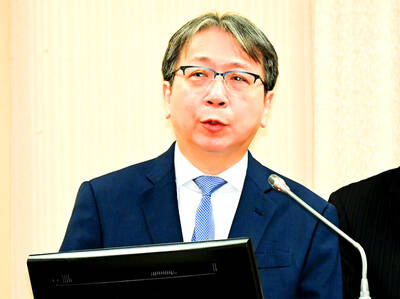Recent satellite photographs show China appears to have built reinforced aircraft hangars on its holdings in the disputed South China Sea, according to a Washington-based think tank.
Pictures taken late last month show the hangars constructed on Fiery Cross Reef (Yongshu Reef, 永暑島), Subi Reef (Jhubi Reef, 渚碧礁) and Mischief Reef (Meiji Reef, 美濟礁) in the Spratly Islands (Nansha Islands, 南沙群島) have room for any fighter jet in the Chinese air force, the Center for Strategic and International Studies (CSIS) said.
“Except for a brief visit by a military transport plane to Fiery Cross Reef earlier this year, there is no evidence that Beijing has deployed military aircraft to these outposts. But the rapid construction of reinforced hangars at all three features indicates that this is likely to change,” the CSIS said in a report.
China claims most of the South China Sea, through which US$5 trillion in ship-borne trade passes every year. Taiwan, the Philippines, Vietnam, Malaysia and Brunei have overlapping claims.
The images have emerged about a month after the Permanent Court of Arbitration in The Hague, Netherlands, ruled against China’s sweeping claims in the resource-rich region, a ruling emphatically rejected by Beijing.
The US has urged China and other claimants not to militarize their holdings in the South China Sea.
“China has indisputable sovereignty over the Spratly Islands and nearby waters,” the Chinese Ministry of National Defense said yesterday in a faxed response to a request for comment. “China has said many times, construction on the Spratly Islands and reefs is multipurpose, mixed and with the exception of necessary military defensive requirements, are more for serving all forms of civil needs.”
The hangars all show signs of structural strengthening, the CSIS said.
“They are far thicker than you would build for any civilian purpose,” Gregory Poling, director of CSIS’ Asia Maritime Transparency Initiative, told the New York Times, which first reported on the new images. “They’re reinforced to take a strike.”
Other facilities including unidentified towers and hexagonal structures have also been built on the islets in recent months, the think tank said.

The US government has signed defense cooperation agreements with Japan and the Philippines to boost the deterrence capabilities of countries in the first island chain, a report by the National Security Bureau (NSB) showed. The main countries on the first island chain include the two nations and Taiwan. The bureau is to present the report at a meeting of the legislature’s Foreign Affairs and National Defense Committee tomorrow. The US military has deployed Typhon missile systems to Japan’s Yamaguchi Prefecture and Zambales province in the Philippines during their joint military exercises. It has also installed NMESIS anti-ship systems in Japan’s Okinawa

TRAGEDY STRIKES TAIPEI: The suspect died after falling off a building after he threw smoke grenades into Taipei Main Station and went on a killing spree in Zhongshan A 27-year-old suspect allegedly threw smoke grenades in Taipei Main Station and then proceeded to Zhongshan MRT Station in a random killing spree that resulted in the death of the suspect and two other civilians, and seven injured, including one in critical condition, as of press time last night. The suspect, identified as a man surnamed Chang Wen (張文), allegedly began the attack at Taipei Main Station, the Taipei Fire Department said, adding that it received a report at 5:24pm that smoke grenades had been thrown in the station. One man in his 50s was rushed to hospital after a cardiac arrest

‘WIN-WIN’: The Philippines, and central and eastern European countries are important potential drone cooperation partners, Minister of Foreign Affairs Lin Chia-lung said Minister of Foreign Affairs Lin Chia-lung (林佳龍) in an interview published yesterday confirmed that there are joint ventures between Taiwan and Poland in the drone industry. Lin made the remark in an exclusive interview with the Chinese-language Liberty Times (the Taipei Times’ sister paper). The government-backed Taiwan Excellence Drone International Business Opportunities Alliance and the Polish Chamber of Unmanned Systems on Wednesday last week signed a memorandum of understanding in Poland to develop a “non-China” supply chain for drones and work together on key technologies. Asked if Taiwan prioritized Poland among central and eastern European countries in drone collaboration, Lin

ON ALERT: Taiwan’s partners would issue warnings if China attempted to use Interpol to target Taiwanese, and the global body has mechanisms to prevent it, an official said China has stationed two to four people specializing in Taiwan affairs at its embassies in several democratic countries to monitor and harass Taiwanese, actions that the host nations would not tolerate, National Security Bureau (NSB) Director-General Tsai Ming-yen (蔡明彥) said yesterday. Tsai made the comments at a meeting of the legislature’s Foreign Affairs and National Defense Committee, which asked him and Minister of National Defense Wellington Koo (顧立雄) to report on potential conflicts in the Taiwan Strait and military preparedness. Democratic Progressive Party (DPP) Legislator Michelle Lin (林楚茵) expressed concern that Beijing has posted personnel from China’s Taiwan Affairs Office to its